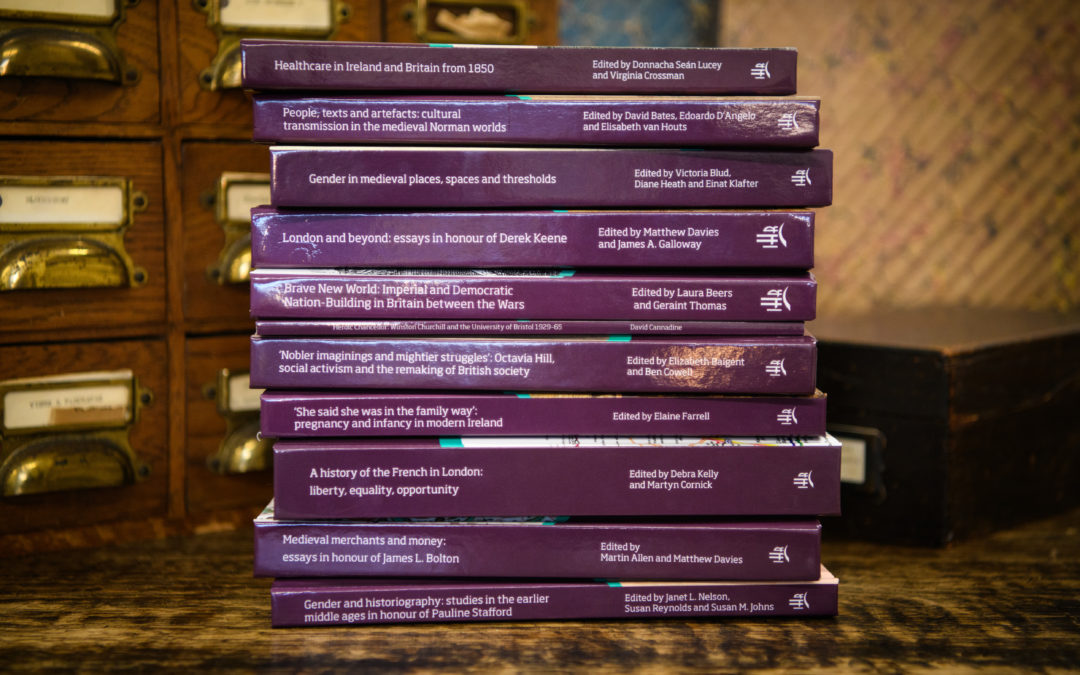By Peter Webster
What’s the status, and value, of the edited essay collection in History publishing? In his new book—The Edited Collection: Pasts, Present and Futures (Cambridge University Press)—Peter Webster considers book chapters and collections as forms of scholarly communication. Peter’s new book is currently available free online until 13 May 2020.
In researching his book, Peter drew on data from the IHR’s Bibliography of British and Irish History (BBIH) which includes records of nearly 620,000 publications relating to the British and Irish past. BBIH is searchable by authors, dates, topics and also publication type, allowing anyone to trace the publishing history of the edited collection from the early 1900s to 2020.
As a publishing format, the edited collection of essays has had a bad press. Collections are widely supposed to contain lesser work than scholarly journals; to be incoherent as volumes, no more than the sum of their parts; and to be less visible to potential readers once published. It’s often claimed that those who make decisions in relation to hiring, promotion, tenure and funding also share this opinion. To publish in or edit an essay collection is thought to risk being penalised for the format, before even a word is read.
But is this a fair assessment?
In my new book, The Edited Collection: pasts, present and futures (Cambridge University Press), I attempt a defence of the format. I explore the modern history of the edited collection and the particular roles it has played. I then examine each component part of the critique, showing either that they’re largely unfounded or (if they are of real substance) that they may be resolved.

Though suspicion of the edited collection is found across the disciplines, it’s most trenchantly expressed from within the hard sciences in which both book chapters and indeed monographs figure little. (In 2014, 99.5 per cent of submissions to REF Main Panel A—for medicine and biological sciences—were journal articles, leaving almost no space for alternative formats such as essays or monographs.)
In the arts and humanities, however, the picture is quite different. Here freestanding edited collections remain a far more significant publishing format, and one—moreover—that’s holding its own in relation to the alternatives.
Data from the Bibliography of British and Irish History shows that, as the scale of history publishing has grown, the relative proportions of monographs, journal articles and book chapters remained all but unchanged between 1996 and 2015. In the 2014 REF, for History, one book chapter was submitted for every 1.7 journal articles. As well as individual chapters, editors also submitted whole edited volumes for assessment as a unit; in the same REF one in five of the books submitted to Main Panel D was an edited volume.
But for historians, as for many across the humanities and social sciences, it’s not just a question of numbers.
In my book I adopt a case study approach to demonstrate the creative potential of the edited collection. The studies I explore show a rich interplay in such volumes, as scholars are brought together to add to—and to assess the state of—an issue, or indeed the current state and purpose of a discipline. On occasions this conversation has been confined within the academy; at other times it’s engaged other professionals outside with particular stakes in the matter under investigation. It has proved a natural vehicle for interdisciplinary enquiry. Such collections may either be the natural outgrowth of an existing group of scholars or the creation by an editor or publisher, sometimes bringing together those with opposing views. What emerges overall, however, is a profoundly communal and conversational endeavour.
One of my case studies is of a form of edited collection that’s peculiar to history: the institutional history, and within this (given my research interests) the histories of cathedrals in particular.
Several of the English cathedral churches date their foundation, or at least the building of their current structures, to the Anglo-Norman period. Consequently, as the end of the twentieth century approached, there was a series of cathedral histories, some of them tied to nine-hundredth or other anniversary commemorations. First off the mark was York Minster, with a volume of essays published in 1977 by the Clarendon Press. The initiative had come from the dean and chapter (the governing body of the minster), against a background of growing interest in its archaeology and its monuments.
An initial editorial committee included Owen Chadwick, regius professor of modern history at Cambridge (and also a priest and person of some influence within the Church of England), who also contributed a chapter. But the volume was also a local affair—edited by Gerald Aylmer, the first professor of history in the still young University of York, and Reginald Cant, canon chancellor of the minster. Most of the other contributors were university-based scholars connected either with Cambridge or York, but the early architecture was covered by Eric A. Gee of the Royal Commission on Historical Monuments, which was based in the city; the chapter on the minster library was by C. B. L. Barr, of the university library, in the custody of which the minster library was kept.
Since then, there has been a crop of similar volumes as the other ancient cathedrals have followed suit. Most of these volumes had some sort of connection with a local university, and involvement from writers associated with the cathedral itself. They have tended to encompass several disciplinary perspectives: national and local history, musicology, archaeology, bibliography and the history of art and architecture.
The combination of these perspectives has varied, however, as has the relative weight of contributions from the city in question and from the wider university sector. Oxford University Press published the volume for Canterbury Cathedral, the principal church in England, in 1995. More than a decade in the planning, the impetus had come both from the Press and from Donald Coggan, archbishop of Canterbury until 1980. All three editors were connected with Canterbury, including Patrick Collinson, regius professor in Cambridge but formerly professor at the University of Kent. However, the team of contributors was overwhelmingly academic and drawn from the universities.
By contrast, the 1994 volume for Chichester was composed of work from a more diverse and locally focused group. It was edited by the cathedral archivist, Mary Hobbs, with the assistance of a historian at the West Sussex Institute of Higher Education (now the University of Chichester), Andrew Foster. The deputy county archivist (in whose care much of the historic archive rests) dealt with the cathedral’s archives and its antiquaries, and Hobbs herself with the library. The chapters on the medieval and early modern cathedral were from specialists, as were those on the architecture and on the cathedral’s art. The twentieth-century chapters, in contrast, were by clergy with a connection with the cathedral.
The cathedral history, then, has been a meeting point of institutional and local history with religious history more broadly, and the concerns of historians of architecture, music, art and of the book. The edited volume has been found to be a useful—indeed, probably the only—means of brokering that interchange.

Peter Webster is a historian based in Chichester, with interests in the history of Christianity in twentieth century Britain. He works at the interface of historical scholarship with digital technologies, with particular interests in digital history and is managing director of Webster Research and Consulting Ltd. His book, The Edited Collection: pasts, present and futures, is freely available from Cambridge University Press until 13 May.
****
BBIH and the edited collection

The Bibliography of British and Irish History (BBIH) The Bibliography of British and Irish History (BBIH) is the largest and most comprehensive guide available to what’s been written about British and Irish history, from the early 1900s to 2020. It’s an essential resource for research and teaching, providing up-to-date information (and links) to nearly 620,000 History books, articles, chapters, edited collections and theses.
New records are added in three annual updates. These records are searchable by a wide range of facets including: title, author, chronology, historical topic, geographical region, and date and form of publication.
To search BBIH for all book chapters published in the past five years, for example, use the Advanced Search to select Type of publication (here: ‘Article in book’, i.e. a book chapter in an edited collection, and restrict the Year of publication to the range 2014-2019 (see below).

This search identifies 9711 freestanding book chapters in edited collections. To further restrict a search by topic, use the Subject tree option to select a field of historical research. Here: Religious history –> Ecclesiastical –> Cathedrals, which pinpoints 65 book chapters published in this 5-year period.

These 65 book chapters are in turn available as a results list, with links to Record Views for individual publications.

Record views for individual chapters—see, for example, below Diane Heath’s 2019 essay ‘Tombscape: the tomb of Lady Joan de Mohun in the crypt of Canterbury cathedral’—provide full details of the edited collection in which they appear (here Gender in Medieval Spaces, Places and Thresholds). Views also record subject and place classifications to identify similar publications (in the following example: all works relating to ‘funerary monuments’, or all publications about ‘Canterbury Cathedral’):

Record Views for a complete edited collection (in this case Gender in Medieval Spaces) provide details and links to all chapters within the volume; and–where available–links to reviews or full texts as Open Access, as below.

The Bibliography of British and Irish History is a research project of the UK’s Institute of Historical Research and the Royal Historical Society, and is published by Brepols. BBIH is a subscription service and is available remotely via university and research libraries worldwide.

